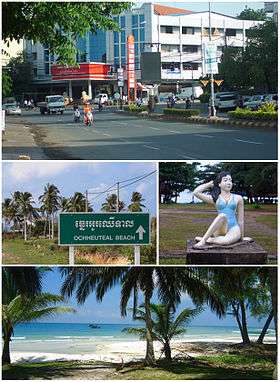Sihanoukville (city)
| Sihanoukville ក្រុងព្រះសីហនុ Krong Preah Sihanouk Preah Sihanouk Kampong Som | |
|---|---|
| City | |
|
Top: Urban commercial center Center left: Road sign in Sangkat 4 Center right: Sculpture at Independence Beach Bottom: Koh Rong Island | |
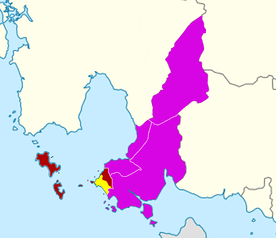 Sihanoukville City's urban area (yellow) in Mittakpheap District (dark red) and Sihanoukville Province (purple) | |
 Sihanoukville | |
| Coordinates: 10°38′N 103°30′E / 10.633°N 103.500°ECoordinates: 10°38′N 103°30′E / 10.633°N 103.500°E | |
| Country |
|
| Province | Sihanoukville |
| City | City of Sihanoukville |
| City | 1964 |
| Named for | Norodom Sihanouk |
| Government | |
| • Mayor | Eav Chanvatanak |
| Area | |
| • Total | 80 km2 (30 sq mi) |
| Elevation | 15 m (45 ft) |
| Population | |
| • Total |
|
| • Rank | Ranked 7th |
| • Urban |
|
| • Urban density | 834/km2 (2,160/sq mi) |
| • District |
|
| Time zone | UTC+07 |
| Postal code | 18000 |
| Area code(s) | 034 |
Sihanoukville (Khmer: ក្រុងព្រះសីហនុ, Krong Preah Sihanouk), also known as 'Kampong Som' (Khmer: កំពង់សោម), is a coastal city in Cambodia and the capital city of Sihanoukville Province, located at the tip of an elevated peninsula in the country's south-west at the Gulf of Thailand. The city is flanked by an almost uninterrupted string of beaches along its entire coastline and coastal marshlands bordering the Ream National Park in the East. A number of thinly inhabited islands – under Sihanoukville's administration[1] – are in the city's proximity, where in recent years moderate development has helped to attract a sizable portion of Asia's individual travelers, young students and back-packers.
The city, which was named in honour of former king Norodom Sihanouk, had a population of around 89,800 people and approximately 66,700 in its urban center in 2008.[2] Sihanoukville city encompasses the greater part of four of the five communes (Sangkats) of Sihanoukville provinces' Mittakpheap District. A relatively young city, it has evolved parallel to the construction of the Sihanoukville Autonomous Port, which commenced in June 1955, as the country's gateway to direct and unrestricted international sea trade. The only deep water port in Cambodia includes a mineral oil terminal and a transport logistics facility.[3] As a consequence, the city grew to become a leading national center of trade, commerce, transport and process manufacturing.[4][5][6]
Sihanoukville's many beaches and nearby islands make it Cambodia's premier seaside resort with steadily rising numbers of national visitors and international tourists since the late 20th century.[7] As a result of its economic diversity, the region's natural beauty and the considerable recreational potential, a constantly increasing number of seasonal and permanent foreign residents make Sihanoukville one of the most culturally varied and dynamic population centers in Cambodia. As of 2014 the tourism sector remains insignificant in comparison with neighboring Thailand. Sihanoukville's future will largely be defined by the authorities' capability of a successfully balanced management in order to protect and conserve natural resources on the one hand and the necessities of island - and urban development, increasing visitor numbers, expanding infrastructure, the industrial sector and population growth on the other.[8][9][10]
Despite being the country’s premier sea side destination, after decades of war and upheaval the town and its infrastructure remain very much disjointed and architecturally unimpressive.[11] Infrastructure problems persist, in particular related to water and power supply, while international standard health facilities remain limited.[12]
Etymology
The official name[13] of the city in Khmer is: Krong (city) Preah (holy) Sihanouk (name of the former king), which adds up to: "City of the holy Sihanouk" or "Honorable Sihanouk City". King Norodom Sihanouk (reigned 1941-1955, 1993-2004) was and still is revered as father of the (modern) nation.[14] The name "Sihanouk" is derived from Sanskrit through two Pali words: Siha (lion), and Hanu (jaws).
The alternative name, Kompong Saom (also romanized as Kompong Som and Kampong Som), (Khmer: កំពង់សោម) means "Port of the Moon" or "Shiva's Port".[15] Saom is derived from the Sanskrit word "saumya", the original (Rig Vedic) meaning of which was "Soma, the juice or sacrifice of the moon-god", but evolved into Pali "moon", "moonlike" "name of Shiva".[16] The word Kampong or Kompong is of Malayan origin[17] and means village or hamlet. Its meaning underwent extension towards pier or river landing bridge.[18]
History
Classical Period (before 1700)
Prior to the ports' and city's foundation works of 1955, the port of Kompong Som must have been only of regional significance - due to the absence of navigable waterways that connect the port with the kingdom's settlement centers. During the many centuries of pre-Angkorian and Angkorian history – from Funan to Chenla and during the Khmer Empire, regional trade was centered at O Keo (Vietnamese: Óc Eo) in the Mekong Delta, now the province of Rạch Giá in Vietnam. The township of Prei Nokor (Saigon) was a commercial center of the Khmer Empire.[19][20][21] The Chronicle of Samtec Cauva Vamn Juon - one of the 18th and 19th century Cambodian Royal Chronicles - briefly mentions the region as the country was split into 3 parts during a 9-year civil war from 1476 to 1485: "In 1479, Dhammaraja took on the throne at Catumukh (Phnom Penh) and controlled the provinces of Samraong Tong, Thbong, Kompong Saom, Kampot up to the Bassak, Preah Trapeang, Kramuon Sah, Koh Slaket and Peam"[mouth of the Mekong].[22]
Early Modern Period (around 1700–1863)
From the end of the seventeenth century, Cambodia lost control of the Mekong River route as Vietnamese power expanded into the lower Mekong. During the Nguyen-Siamese War (1717–18) a Siamese fleet burned the port of Kompong Som in 1717 but was defeated by the Vietnamese at Banteay Meas/Ha Tien.[23] A Cambodian king of the late eighteenth century, Outey-Reachea III allied with a Chinese pirate,[24] Mac-Thien-Tu, who had established an autonomous polity based in Ha Tien and controlled the maritime network on the eastern part of the Gulf of Thailand.[25] Ha Tien was located at a point where a river linking to the Bassac River flows into the Gulf of Thailand. Landlocked Cambodia tried to keep its access to maritime trade through Ha Tien. In 1757 Ha Tien acquired the ports of Kampot and Kompong Som as a reward for Mac's military support to the King of Cambodia. Until its destruction in 1771 the port developed into an independent duty-free entrepot - linked with several Chinese trading networks.[26]
Alexander Hamilton, who traveled on the Gulf of Thailand in 1720, wrote that "Kompong Som and Banteay Meas (later Ha Tien) belonged to Cambodia, as Cochin-China was divided from Cambodia by a river (Bassac river) of three leagues broad." and "King Ang Duong constructed a road from his capital of Oudong to Kampot". Kampot remained the only international seaport of Cambodia. "The traveling time between Udong and Kampot was eight days by oxcart and four days by elephants." French Résident Adhemard Leclère wrote: "...Until 1840s, the Vietnamese governed Kampot and Péam [Mekong Delta], but Kompong Som belonged to Cambodia. The Vietnamese constructed a road from Ha Tien to Svai village - on the border with Kompong-Som - via Kampot."[27]
The British Empire followed a distinct policy by the 1850s, seeking to consolidate its influence. Eye witness reports give rare insights, as Foreign Secretary Lord Palmerston's agent John Crawfurd reports: "Cambodia was...the Keystone of our policy in these countries, - the King of that ancient Kingdom is ready to throw himself under the protection of any European nation...The Vietnamese were interfering with the trade at Kampot, and this would be the basis of an approach..." Palmerston concluded: "The trade at Kampot - one of the few remaining ports, could never be considerable, in consequence of the main entrance to the country, the Mekong, with all its feeders flowing into the Sea through the territory of Cochin China The country, too, had been devastated by recent Siam - Vietnam wars. Thus, without the aid of Great Britain, Kampot or any other port in Cambodia, can never become a commercial Emporium." Crawfurd later wrote: "The Cambodians... sought to use intervals of peace in the Siam - Vietnam wars to develop intercourse with outside nations. The trade at Kampot which they sought to foster was imperiled by pirates. Here is a point where the wedge might be inserted, that would open the interior of the Indo-Chinese Peninsula to British Commerce, as the great River of the Cambodians traverses its entire length and even affords communication into the heart of Siam".[28]
French rule (1863–1954)
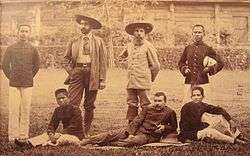
and Pierre Lefèvre-Pontalis in 1893
with Cambodian interpreters
Under French rule Vietnam, Laos and Cambodia became a single administrative and economic unit. The coastal region Circonscription Résidentielle with Kampot as its capital contained the Arrondissements of Kampot, Kompong Som, Trang and Kong-Pisey. The establishment of another international trading center near the existing city of Saigon was not considered necessary. Focus remained the Mekong and the idea to establish an alternative route to Chinese and Thai internal markets along an uninterrupted navigable waterway all the way south to the Mekong Delta.[29]
Insurrection
An insurrection that took place from 1885 to 1887 further discouraged French ambition. It started in Kampot and quickly spread to Veal Rinh, Kampong Seila, and Kompong Som, where the insurgents were led by a Chinese pirate named Quan-Khiem. He managed to control the northern part of Preah Sihanouk for some time until he – an old man - was arrested by the local governor.[27]
The most notable infrastructural improvements of this period were the construction of Route Coloniale No. 17, later renamed National Road No.3 and the national railway system, although work on the "Southern Line" - from Phnom Penh to Sihanoukville - only began in 1960.
After independence (since 1954)
The city's and province's alternative name Kampong som (Kampong Som) was adopted from the local indigenous community. After the dissolution of French Indochina in 1954, it became apparent that the steadily tightening control of the Mekong Delta by Vietnam required a solution to gain unrestricted access to the seas. Plans were made to construct an entirely new deep-water port. Kompong Saom (Kampong Som) was selected for water depth and ease of access. In August 1955, a French/Cambodian construction team cut a base camp into the unoccupied jungle in the area that is now known as Hawaii Beach. Funds for construction of the port came from France and the road was financed by the United States.[30]
During the Vietnam War the port became an intensive military facility on both sides, in the service of National Front for the Liberation of South Vietnam and after 1970, under the government of Lon Nol, in the service of the United States.[31]
The port was the last place to be evacuated by the US Army, only days before Khmer Rouge guerrillas took control of the government in April 1975. The events surrounding the taking of the US container ship SS Mayaguez and its crew on 12 May by the Khmer Rouge and the subsequent rescue operation by US Marines played out on the waters of Koh Tang off the coast of Sihanoukville. During the two days of action, the US commenced air strikes on targets on the mainland of Sihanoukville including the port, the Ream Naval Base, an airfield, the railroad yard and the petroleum refinery in addition to strikes and naval gun fire on several islands.[32]
After the fall of the Khmer Rouge regime in 1979 and the subsequent opening of the economy, the port of Sihanoukville resumed its importance in the development and recovery of the country. With the further opening of new markets in 1999, the city regained its role in the economic growth of Cambodia.[33]
In 1993, the Ream National Park was established per royal decree of former King Sihanouk.[34]
The Sihanoukville Municipality was elevated to a regular province on 22 December 2008 after King Norodom Sihamoni signed a Royal Decree converting the municipalities of Kep, Pailin and Sihanoukville into provinces.[35]
In 2006 the Koh Puos (Cambodia) Investment Group submitted an application, planning to invest $276 million in converting the 116-hectare Koh Puos - Snake island into a luxury residential - and resort complex. After the completion of certain elements of the infrastructure, the investor announced alterations of the original blueprints, as "Reapplying for permission will happen in 2014..." according to the Council of the Development of Cambodia.[36][37]
On 26 May 2011 Preah Sihanouk area joined the Paris-based club Les Plus Belles Baies Du Monde (The most Beautiful Bays in the World). The organisation officially accepts the Bay of Cambodia as one of its members at the 7th General Assembly.[38]
Geography
Topography
Sihanoukville town is located at the tip of the rolling hills of a peninsula at the Gulf of Thailand. To its North-West and at its center it rises up to 15 metres (49 ft) above sea level, whereas the land gently and steadily flattens towards extended coastal plains, marshlands and beaches in the South and South-East. These hills, that provide a great variety of housing ground, good perspectives on the coastal plains, the beaches, the sea and the islands define the region's natural character and value. Another agreeable fact is the Gulf of Thailand's low depth and the local climate - very moderate in contrast to the South China sea to the East and the Indian ocean in the West, where taifuns and monsoonal extremes are permanent perils.[39]
Architecture and city-scape
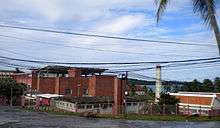
an example of New Khmer Architecture
designed by Vann Molyvann
As a result of its clearly defined purpose, its very brief but turbulent history and its location, Sihanoukville is distinct from other urban centers in Cambodia. Established after the period of the French Protectorate, bourgeois colonial style quarters as in Kampot, Siem Reap or Phnom Penh do not exist. Architecture and street layout are subject to modern concepts of reduction and functionality. Famous Cambodian architect Vann Molyvann designed elegant objects, public buildings with a distinct function, some still operational. This brief era of New Khmer Architecture ended in 1970 - inconsistency and chaos during the long civil wars had far greater impact on the city's current image.[40][41]
In 1959 the first urban plan for the city was completed for a population of 55,000 residents; it included cycle paths and green spaces. The plan also clearly marked out zoning for the port, the railway network, the town center with municipal offices, business and residential housing, and finally a tourist zone to the south along the beaches. A feasibility study by the United States Operations Mission (USOM) looked at drawing new water supply from the Prek Tuk Sap and existing lagoons; these were subsequently improved (cut off from the sea) and used as the initial source for town supply. The reservoirs are still operational, although insufficient for today's demands.[42]
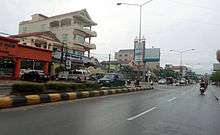
The years of turmoil that followed meant that little of the original plan was implemented. The current state of structural inconsistency is testimony to decades of upheaval as layout planning was by no means a subject of aesthetic considerations and applied sciences.
Beginning at the port, a moderate raster of streets spans up to the Weather Station Hill (Victory Hill) and along the local (Victory) beach. Between the National Bank complex and Victory beach pier is one of the very few spots in town, that give the impression to have been planned in advance. The area connects with the city's center along a single highway via typical irregular successions of residential buildings, bare of any distinct features and landmarks. These highways were designed to connect the very few and widely dispersed actual settlement foundations. The neighborhoods lack intimacy, due to a one-dimensional infrastructure. The city's center is a sequence of alternating single blocks of solid urban edifices, such as banks, middle-class hotels, gas stations, pharmacies, Chinese bakeries and electronic retailers followed by long rows of low-end food stalls, makeshift shops, motor-bike repair services, mini-markets, laundry, gas, lock-picker services and mobile phone shops.[43][44]
Gallery of Ochheuteal/Serendipity Beach area
 Iconic Landmark: The Golden Lions Roundabout
Iconic Landmark: The Golden Lions Roundabout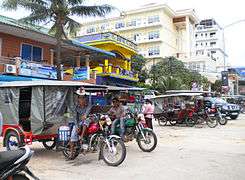 Tuk-tuks in Serendipity Road
Tuk-tuks in Serendipity Road Serendipity Road
Serendipity Road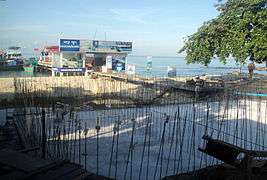 Island Ferry Pier, 2015 in front construction site of new citywide sewage system[45]
Island Ferry Pier, 2015 in front construction site of new citywide sewage system[45]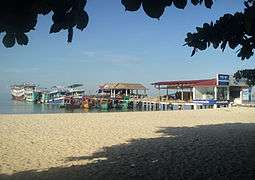 ferries and excursion boats at Serendipity pier in June 2015
ferries and excursion boats at Serendipity pier in June 2015
Beaches
Sihanoukville's beaches are one of the city's most valuable ecological and economic resource with varying degrees of commercial exploitation. The beaches listed in this section do not include any of the island's beaches.
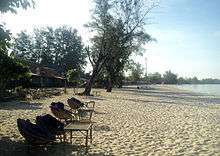

- Ochheuteal Beach, ឆ្នេរអូរឈើទាល: is a 3.3 km (2 mi) long strip of white sand beach and although the name translates to "Creek/Estuary of the Tiel tree" it is lined with Casuarina and Tamarisk trees. Grass umbrellas, rental chairs in front of around 30 standardized beach huts serve meals, drinks and entertainment. Well established middle class hotels and high-profile residences flank the beach along its Northern part. The sustainability of Ochheuteal beach was a primary consideration of various stakeholders, which brought about the development of a tourism development and management plan in 2005. The Southern half remains - apart from some hotels at its far end - essentially undeveloped.[46]
- Serendipity Beach: is the northern end (roughly one fifth or 600 m) of Ochheuteal Beach, is very popular with tourists, named by an American.[47][48]
- Otres Beach, ឆ្នេរអូរត្រេស: is around 4.6 km (3 mi) long and beyond the small "Queen hill" headland at the southern end of Ochheuteal Beach. Its long white sand strip, also completely lined with Casuarina and Tamarisk trees, is far less developed and commercialized than Ochheuteal Beach and has developed into a preferred lodging place for Western visitors. From 2004 to 2011 this beach was occupied by numerous bungalows and dormitories, run by Western people. Due to the element of illegality of on-beach accommodation, among other reasons, police cleaned up the area in May 2011, removing the greater part of the beach-side bungalows. Permanent structures beyond the beach road supplement the remaining places since 2012. It is a very popular, well established holiday retreat – where prices have risen considerably over the course of the last years.[47]
- Sokha Beach: Sokha Beach is around 1.2 km (1 mi) long and located west of Serendipity Beach. The beach is privately owned by - and its southern half occupied by the Sokha Beach Hotel,[49] the first five-star luxury beach hotel in Cambodia. While the beach is well kept and many facilities are provided, visitors have to pay for their use and beach vendors are not allowed.
- Independence Beach: Independence Beach is around 1.3 km (1 mi) long and located north-west of Sokha Beach. The beach is named after the Independence Hotel, another example of New Khmer Architecture, towering on top of a rock at the beaches northern end.
- Victory Beach: Victory beach is around 300 metres (980 feet) long and situated at the furthest north of the peninsula of Sihanoukville. It was heavily used by backpackers and is still popular with budget travelers. The deep water port is located at the northern end of the beach. A consortium of Russian business people undertook large scale development here. The beach is regularly maintained.
- Lamherkay/Hawaii Beach: is the southern succession of Victory Beach, situated north of Independence Beach. It is a strip of similar length as Victory Beach - around 300 m. Here is the very place where the French/Cambodian construction team's groundwork began for the construction of the Sihanoukville Autonomous Port in 1955.
- Treasure Island Beach south of Lamherkay/Hawaii Beach is less than 50 metres (160 feet) long and its entire length is fringed with concrete steps and wooden pavilions of a big Cambodian seafood restaurant.
- Hun Sen (Prek Treng) Beach, ឆ្នេរព្រែកត្រែង: is the northernmost beach of the city with a length of around 1.5 kilometres (0.93 miles), situated behind the local port and essentially empty without beach huts and bars, it sees only weekend - and holiday visitors. The water is very shallow, but the area is lacking favorable infrastructure and is not regularly cleaned.
Islands

center top left: Koh Bong Po'on
center top right: Koh Rong Resort
center bottom: Koh Rong Sanloem
bottom left: Koh Tuich
bottom right: Koh Dek Koul
All the islands listed below fall under administration of Sihanoukville's Mittakpheap District. The majority is either in the process of or has been assigned for extensive touristic development. Koh Rong and Koh Rong Sanloem in particular have so far undergone years of non-coordinated and individually undertaken development. A number of guesthouses and bungalow resorts offers accommodation of greatly varying standard by the beaches or in the lush jungle. Despite the very moderate infrastructure, visitor numbers have risen quickly and Koh Rong has been declared a stop on the Banana Pancake Trail.[50]
- Koh Rong, កោះរ៉ុង: Situated 26 km (16 mi) west of the Sihanoukville coast. Koh Rong is the biggest of the islands of Sihanoukville province. It encompasses an area of 78 km2 (30 sq mi). The terrain is predominantly hilly with a sizable mountain 316 metres (1,037 ft) at the island’s north-west. The hills provide water for creeks, lagoons and estuaries. The island’s interior is almost completely forested. Although there are already lots of guest houses and pubs in and around Koh Tuich village, the island remains virtually deserted – its sheer size dwarfs all settlement centres. As of 2016, there is a well-functioning ferry network between Sihanoukville and Koh Rong.
- Koh Rong Sanloem, កោះរុងសន្លឹម: South of Koh Rong and smaller, beautiful beaches are on the west and east coast. It resembles its bigger neighbour Koh Rong in shape and geography – although a bit thinner, it is covered in dense forest, generally more flat (still, though there are sizable hills) and has noticeably less landmass in relation to its coastline. Marine life around Koh Rong Sanloem is very diverse and offers many diving spots. As of 2016, there is a well-functioning ferry network between Sihanoukville and Koh Rong Sanloem.
- Koh Kaong Kang/Thass, កោះកោងកាង/ថាស: Mangrove Island, Ile des Paletuviers (old French name), Koh Kaong Kang/Thass – one of the inner islands – it is a popular place for snorkelers. Koh Kaong Kang/Thass is very flat, hence freshwater is scarce - one of the reasons why nobody lives there permanently.
- Koh Koun, កោះកូន: Child Island, Ile de Cone (old French name), a small island between Koh Rong and Koh Rong Sanloem, has no beach, is uninhabited, but a popular dive - and snorkel spot.
- Koh Tuich, កោះតូច: Small island, a tiny and beautiful island off Koh Rong island’s Koh Tuich village. There is a little pagoda on it in service since around 2010. Shallow waters provide good snorkeling spots around the whole island.
- Koh Puos, កោះពស់: also known as Snake Island or Morakot Island. This island lies 800 metres (2,625 ft) off Sihanoukville's Victory Beach. It is under development by Russian investors and converted into a luxury holiday destination and high standard residential area.[51] Snake Island is linked to the mainland via a regular road bridge since around July 2011. The bridge is currently not open for public traffic.
- Koh Dek Koul, កោះដេកកោល: This small island lies 7 kilometres (4 mi) off Victory Beach and only a further few hundred metres off Snake Island. The Russian Mirax Luxury Resort corporation operates a hotel business on this predominantly rocky island.
- Koh Bong Po-oun/Song Saa, កោះបងកោះប្អូន: – Siblings/Lovers Islands – Les Frères (old French name), renamed to Koh Song Saa – Lovers islands – two tiny islets off Koh Rong’s north-east, it is home of the exclusive Song Saa Resort.

Climate


Sihanoukville lies in the Tropical monsoon (Am) climate zone. The city has two seasons: a wet season and a dry season.
The maximum mean is about 30 °C (86 °F) ; the minimum mean, about 24 °C (75 °F). Maximum temperatures of higher than 32 °C (90 °F), however, are common and, just before the start of the rainy season, they may rise to more than 38 °C (100 °F). Minimum night temperatures sporadically fall below 20 °C (68 °F).[52] in January, the coldest month. May is the warmest month - although strongly influenced by the beginning of the wet season, as the area constitutes the easternmost fringe of the south-west monsoon. Tropical cyclones only rarely cause damage in Cambodia.
The total annual rainfall average ranges between 1,000 and 1,500 millimeters (39.4 and 59.1 in). The maximal amounts fall in August and September. Relative humidity is high throughout the entire year; usually exceeding 90 percent. During the dry season daytime humidity rates average around 50 percent or slightly lower, climbing to about 90 percent during the rainy season.
| Climate data for Sihanoukville, Cambodia | |||||||||||||
|---|---|---|---|---|---|---|---|---|---|---|---|---|---|
| Month | Jan | Feb | Mar | Apr | May | Jun | Jul | Aug | Sep | Oct | Nov | Dec | Year |
| Average high °C (°F) | 31.3 (88.3) |
31.2 (88.2) |
32.1 (89.8) |
33.7 (92.7) |
32.3 (90.1) |
31.2 (88.2) |
30.0 (86) |
30.8 (87.4) |
30.8 (87.4) |
30.8 (87.4) |
31.2 (88.2) |
31.7 (89.1) |
31.43 (88.57) |
| Average low °C (°F) | 23.9 (75) |
24.6 (76.3) |
25.4 (77.7) |
25.0 (77) |
26.8 (80.2) |
26.3 (79.3) |
25.9 (78.6) |
25.1 (77.2) |
25.2 (77.4) |
24.7 (76.5) |
24.4 (75.9) |
23.5 (74.3) |
25.07 (77.12) |
| Average precipitation mm (inches) | 28.3 (1.114) |
25.2 (0.992) |
50.3 (1.98) |
124.8 (4.913) |
207.3 (8.161) |
252.7 (9.949) |
341.4 (13.441) |
377.2 (14.85) |
320.6 (12.622) |
290.4 (11.433) |
138.2 (5.441) |
54.4 (2.142) |
2,210.8 (87.038) |
| Source: world weather online[53] | |||||||||||||
Economy
Sihanoukville was established to open an international marine gateway and as a result the local economy is largely defined by the imperatives of its deep water port and the nearby oil terminal. Attached is a regularly modernized[54] cargo storage - and logistics facility which serves numerous shipping companies, freight forwarders, suppliers and maintenance contractors. All of these are based in the port's vicinity.[55] The Phnom Penh - Sihanoukville transport corridor is the premier national trade route, accounting for about 75 percent of Cambodia’s trade traffic.[56]
Other sizable economic sectors of the city are fishery, aqua-cultures and frozen shrimp processing, the garment industry, food production and processing, the constantly growing tourism industry with a noticeably developed[57] service branch and the associated real estate market.[58]
Sihanoukville Special Economic Zone

The Sihanoukville Special Economic Zone (SSEZ) is an overseas economic and trade cooperation zone which was designed to promote favorable market conditions[59] such as: policy advantages, a safe political environment, favorable trade status, completed infrastructure supporting, low labor cost and excellent services, among others. In addition to its areas around the port, a sizable industrial center, exclusively composed of Chinese companies has been developed since around 2010.[60][61]

| businesses according to people employed (whole province) | |||||||||||||||||||||
| Size of Establishment | Number of Establishments | ||||||||||||||||||||
|---|---|---|---|---|---|---|---|---|---|---|---|---|---|---|---|---|---|---|---|---|---|
| 1-10 persons | 10,424 | ||||||||||||||||||||
| 11-50 persons | 177 | ||||||||||||||||||||
| 51-100 persons | 19 | ||||||||||||||||||||
| 101 or more | 29 | ||||||||||||||||||||
| Total | 10.649 | ||||||||||||||||||||
| Source: Cambodiainvestment - Preah-Sihanouk-Province[62] | |||||||||||||||||||||
Major Companies
- Eurogate Garment Limited
- Sary Paper Co., Ltd.
- K. Som Textile Co, Ltd
- Javelin Co., Ltd Industrial steel processing
- Angkor Beer
Trade
Trading accounts for a high percentage of the city's economy as patterns have undergone development since the middle 1980s, when the Soviet Union heavily influenced Cambodia’s trade. The city imports many goods from Thailand, Hong Kong, Singapore and China while it exports goods to the United States, Canada, Germany and the United Kingdom. The city often re-exported many of the goods it imported such as electronics, cigarettes, vehicles and gold. Today, the city’s main export is garments, but it also produces and exports timber, logs, and rubber in small quantities.[63][64]
Cambodia is one of the few Least Developed Countries (LDCs) to export over $2 billion. Since Cambodia became the first LDC to join the World Trade Organization (WTO) in 2004, trade has steadily increased, and the U.S. has been Cambodia’s largest trading partner. Comparing to $2.3 billion of export to the U.S and $153 million of export to Cambodia in 2010, from January to October 2011, Cambodia’s exports to the U.S. were $2.29 billion and U.S. exports to Cambodia were $152.6 million.[65][66]
Commercial banks located in Sihanoukville: Cambodia Commercial Bank, Union Commercial Bank, Cambodia Asia Bank, Cambodia Public Bank, Foreign Trade Bank[62]
Economic Prospects
The City's development strategy focuses on tourism, port expansion, and industrial growth. Tourism development is expected to be an economic driver leading to the development of a national commercial center and is already producing rapid growth in the surrounding area. It is anticipated that the port, as a hub for the expansion of maritime transport, will attract additional industry. An industrial zone has been established that includes petrochemical production and food processing based on local fisheries and other elements. With new investments in these areas and associated development strategies, planners anticipate increased urbanization of Sihanoukville, alongside growing economic opportunities that will lead to migration from rural areas.[62]
Foreign investment in Cambodia has increased significantly since 2004 led by Asian investors from countries such as Malaysia, China, Korea, Thailand, and Vietnam. Approved investment proposals by the Council for the Development of Cambodia totaled around $500 million in 2011.[65]

Sihanoukville Port Special Economic Zone
The Sihanoukville Autonomous Port has an independent administration. In combination with the related logistics - and transport sector it is the city's economic backbone.
At present, the total operational land area of the Sihanoukville Autonomous Port is around 124.76 ha. The Old Jetty was constructed in 1956 and became operational in 1960. The jetty is 290 metres (950 feet) long by 28 metres (92 feet) wide and can accommodate 4 vessels with medium GRT at both sides. The exterior berth is −8.50 to −13 metres (−27.9 to −42.7 feet) depth, while the interior berth is −7.50 to −8.50 metres (−24.6 to −27.9 feet) depth.
In order to cope with the increasing rates of cargo throughput, the Royal Government of Cambodia had constructed another 350 m (1,148 ft) long new quay with −10.5 m (−34 ft) maximum draft in 1966. At present, this new quay can accommodate 3 vessels with −7 m (−23 ft) draft medium GRT.[67] The construction of the Container Terminal, 400 m (1,312 ft) long by −10.5 m (−34 ft) depth and a 6.5 ha (16 acres) container yard was completed in March 2007.[68]
| Sihanoukville Autonomous Port Traffic Rates[69] | ||||||||||||||
| Item | 2003 | 2004 | 2005 | 2006 | 2007 | 2008 | 9M2009 | |||||||
|---|---|---|---|---|---|---|---|---|---|---|---|---|---|---|
| Gross Throughput (Tons) | 1,772,361 | 1,503,050 | 1,380,847 | 1,586,791 | 1,818,877 | 2,057,967 | 1,405,338 | |||||||
| Not Included Fuel | 1,454,856 | 1,242,011 | 1,131,699 | 1,320,102 | 1,428,992 | 1,605,672 | 958,279 | |||||||
| Not Include Fuel &Cont. | 650,329 | 308,153 | 107,929 | 197,573 | 193,573 | 291,114 | 162,520 | |||||||
| Cargo containerized | 804,527 | 933,858 | 1,023,770 | 1,122,529 | 1,235,419 | 1,314,559 | 795,759 | |||||||
| Container throughput (TEUs) | 181,286 | 213,916 | 211,141 | 231,036 | 253,271 | 258,775 | 157,639 | |||||||
| Vessel calling (units) | 878 | 730 | 686 | 912 | 876 | 954 | 642 | |||||||
The primary destinations of Sihanoukville Autonomous Port are: Singapore, Hong Kong, Bangkok, Ho Chi Minh, Shanghai, Laem Chabang, Yantian and Kaohsiung. It has a frequency of scheduled services of 38 per week.[70][71]
Transport
Roads and Streets
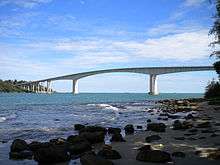
- National Highway 4: Phnom Penh and Sihanoukville are connected via the National Road 4. The road was built and financed by the United States to accommodate heavy freight containers and gasoline tank trucks connecting the deep-water port with Phnom Penh. There are three toll stations along its entire distance of around 250 km (155 mi). However, it is considered the most dangerous road of Cambodia. Residential areas and the attached local traffic merges with the speedy National Road express traffic - severe traffic accidents result.[72]
- National Highway 3: Connects Sihanoukville with Kampot province. The road joins the NR4 at Prey Nob district at the junction town of Veal Rinh. It is sealed, but lacks traffic signs. Free roaming cattle and other livestock regularly block road traffic. The road underwent significant refurbishment in 2008 and forms part of an international "North-South economic corridor" from Kunming in China to Bangkok in Thailand.[73]
- National Highway 48: Connects Sihanoukville and Phnom Penh with Koh Kong Province,to the southwest of Cambodia. The road ends at the Thai-Cambodian border. The old 4 ferry crossing points over the estuaries along the route were replaced by solid bridges. This road has very little traffic.
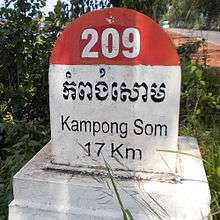
Roads in Sihanoukville city are in relative good condition, although smaller streets, in particular in neighborhoods tend to be non-maintained dirt tracks, unless upgraded through the local communities' initiatives.[74]
Urban Traffic
Cambodia follows the right-hand traffic. There is no formally adopted road and road transport policy in Cambodia, and this particularly affects urban road transport.[75]
Although Cambodia's traffic laws[76] are profoundly the same as those of any other country, with respect to the country's membership of the ASEAN, that requires recognition of ratified agreements,[77] regular traffic only functions on a basic level and in times of low density. Conduct is still traditional as smaller and slower vehicles are expected to yield to big vehicles, usually driven by perceived wealthier and socially superior people.[78][79] Nationwide, pedestrians have to walk beside the roads and are - again traditionally - considered poor, inferior and bare of any prerogative. Sidewalks in all cities are being completely occupied and obstructed by businesses and/or used as parking lots, rendering them completely useless - although not allowed according to article 5 of the General provisions of the Traffic Law: "Sidewalks are the roadsides in cities or towns, which are prepared for pedestrians. The sidewalks are not allowed for vehicles to park."[76]
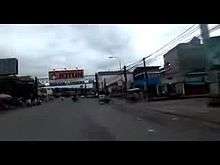
Law enforcement has been accused of failing to enforce international norms. A habit of running predictable checkpoints has developed over the last years. Tourists on rental bikes and common people are often stopped and forced to pay indiscreet sums, often based on mere assumptions and unsupported claims. Drivers of vehicles with perceived social status remain generally unmolested. Consequently, the educational effect of these activities is very low.[80]
In all urban and residential areas an overabundance of motorbikes exists due to the absence of any form of public transportation and taxi-cars. For non-residential and inexperienced people Sihanoukville city remains unsafe for driving. Drivers of motorbikes often do not wear helmets, drive indiscriminately on any side of the street and it is common to see motorbikes with more than two passengers or vehicles driven by children and underaged people. Traffic lights are often ignored.[81][82]
In 2008 the government ordered the countrywide enforcement of the use of helmets, but order was not thoroughly enforced.[83][84][85]
Public and Individual Transport
The city does not have any form of public transportation. Local administration does issue transport licences for any individual of the informal urban transportation system of motor-taxis (moto-dups) and tuk-tuks. The system is not administered by authorities, as anybody can become a motor-taxi - or tuk-tuk driver. As a consequence, prices of services are ad-hoc, insurance non-existent and service quality varies considerable. The overwhelming majority of drivers do not have knowledge of street names and/or numbers.[86]
Airport

The Sihanoukville International Airport, (KOS) formerly called Kang Keng Airport (ព្រលានយន្តហោះ កង កេង) named after the Minister of Health of the Khmer Republican regime during the 1970s. Airport is located in the Ream commune in central Sihanoukville province. It lies close to the National Highway No.4, only around 500 metres (1,600 feet) from the Ream beach on top a former filled in and drained mangrove lagoon, just about 18 kilometres (11 miles) from Sihanoukville City.
October 2014: Only international charter flights[87]
Long Distance Buses and Taxis

The central long-distance bus station for all transport business operators[88] is located on National Highway No. 4 in the city's north-east near the Autonomous Port. Transport business operators maintain booking offices in the urban centers.
Sihanoukville is served by many competing companies[89] with daily scheduled services from and to all major population centers in Cambodia. Direct destinations are Phnom Penh, Koh Kong (city) and Kampot. Some companies offer services to Ho Chi Minh City in Vietnam and to Siem Reap near Angkor Wat. Buses operate from the early morning until the afternoon plus a daily night-bus/sleeper.[90]
Privately operated taxi stands for long distance transportation are situated at the central bus station, in the commercial urban center and the tourist center in the South.
Marine Transport, Island Access, Ferries
The last daily national official marine ferry service from/to Sihanoukville city to/from Krong Koh Kong ceased operation with the completion of National Highway 48 in 2007.
Koh Rong island and Koh Rong Sanloem island have daily ferry service.[91]
Access to smaller islands is generally provided by local holiday resorts, dive operators or private operators. Additionally, small long-tail boats and medium size cruising boats can be individually hired for sightseeing, fishing, diving and drinking trips at guest-houses, travel agencies and diving operators.
Marina Oceania - the first marina in Cambodia operational and fully equipped since 2013 for yachts and boats up to 25 metres (82 feet) with 4-to-5-metre-deep (13-to-16-foot) berths for 20 boats. It is situated at the local port's pier, near Koh Preab island. (coordinates: 10° 39' 59" N / 103° 30' 41" E).[92]
Holiday Cruise ships infrequently stop by at the port during their voyages in South-East Asia.[93]
Rail Transport
The moderate railway network of Cambodia was re-constructed for freight transport during the last years by Toll Holdings, which has obtained a building and maintenance concession from the Royal Cambodian Railway.[94] The "Southern line", constructed 1960-1969 with a length of 264 km (164 mi), connects the Sihanoukville Port Special Economic Zone with the capital Phnom Penh.
The currently rather deteriorated train station near the Autonomous Port used to manage passenger train transportation to Phnom Penh via Kampot before 1975.
Demographics

The 2008 census of Cambodia counted 89,846 inhabitants of Sihanoukville City and approximately 66,700 in its urban center.[95]
The population of the city is apart from descendants of the indigenous inhabitants not older than 3 generations as the product of recent history, such as the Cambodian diaspora and Cambodian humanitarian crisis of and after the Pol Pot era. Historic events which led to demographic upheavals in Cambodia are evident in the demographic trends of the city. With the arrival of displaced refugees, in subsequent decades and centuries, a non-Khmer, mixed Asian population grew to a high percentage of the total population in the core population in urban areas.
| Population Projections for Sihanoukville Province 2008-2016[96] | |||||||||||||||||||||
| Year | 2008 | 2009 | 2010 | 2011 | 2012 | 2013 | 2014 | 2015 | 2016 | ||||||||||||
|---|---|---|---|---|---|---|---|---|---|---|---|---|---|---|---|---|---|---|---|---|---|
| Total | 229,205 | 235,095 | 241,154 | 247,355 | 253,654 | 260,034 | 266,470 | 272,933 | 279,419 | ||||||||||||
| Male | 114,680 | 117,735 | 120,872 | 124,076 | 127,324 | 130,607 | 133,913 | 137,227 | 140,545 | ||||||||||||
| Female | 114,525 | 117,360 | 120,282 | 123,279 | 126,330 | 129,427 | 132,557 | 135,706 | 138,874 | ||||||||||||
| Annual Growth | 2.57 | 2.58 | 2.57 | 2.55 | 2.52 | 2.47 | 2.43 | 2.38 | |||||||||||||
| Sex Ratio | 100.1 | 100.3 | 100.5 | 100.6 | 100.9 | 101.0 | 101.1 | 101.2 | 101.3 | ||||||||||||
| Median Age | 21.8 | 22.3 | 22.8 | 23.3 | 23.7 | 24.2 | 24.7 | 25.1 | 25.6 | ||||||||||||
In addition to Khmer, ethnic groups like Vietnamese, Chinese, Cham, Thai, Korean, French, British, Europeans, Australians and Americans live in the urban area. Due to its status as an international port, high volume and density of commerce and the impact of the service sector related to the tourist industry, Krong Preah Sihanouk has a relative high Human Development Index (HDI)of 0.750, compared to the national average HDI of 0.523.[97]
Health
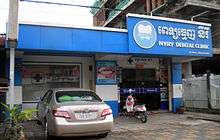
Cambodia still has one of the worst health statuses in Asia, although the situation is slowly changing for the better. The public health system has suffered from war and neglect and has had serious difficulties meeting the health needs of the population. Some government hospitals and other health units have been rehabilitated so that they are autonomous entities, staffed with qualified personnel. This has led to a significant increase in the utilization of health services. At the same time, modern standard private clinics, including local and foreign service providers, are increasing in number and are competing with State-owned hospitals.[98]
Sanitation practices in rural Cambodia are often primitive. The water supply is the main problem; rivers and streams are common sources of drinking water and of water for cooking. These water sources are often the same ones used for bathing, washing clothes, and disposing of waste products. Adequate sewage disposal is nonexistent in most rural and suburban areas.[99]
Local pharmacies provide a limited supply of prescription medications, but the quality of locally obtained medications varies greatly. Counterfeit medication is readily available and might be indiscernible from authentic medication, and can be potentially dangerous.[100]
"All travelers to Cambodia should be up-to-date with their routine immunizations and should be protected against hepatitis A and B and typhoid fever."[101]
Hospitals/ Clinics with emergency service[102]
- Preah Sihanouk Referral Hospital[103]
- C.T Clinic
- International Hospital
Culture
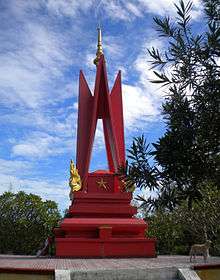
The majority of municipal inhabitants are of East-Asian descent, who profoundly characterize and influence local customs, moral, commerce, cuisine and tradition based on Pan-East-Asian beliefs and ideas. Cambodian culture is of distinct ancient Khmer origin, accompanied by century-old moderate Chinese and Vietnamese cultural influences.[104] The prolonged presence of foreign and in particular Westerners in Cambodia and Sihanoukville town contributes to a noticeable varied, modern, multi-cultural manifestation, which is increasingly influenced by modern media.[105]
The citizens of Sihanoukville city celebrate all religious, traditional and secular festivities such as Cambodian New Year (April), Chinese New Year (between January and February), Water Festival (November), Pchum Ben (honor to the ancestors in October) and Kathen Ceremony (offerings to the monks), 8 January (Day of Cambodian - Vietnamese Friendship) among others.
Many urban families of Chinese or Sino-Khmer descent[106][107] in Sihanoukville city have for most of Cambodia's history constituted the commercial elite and urban upper classes. Besides the expressed Buddhist faith there is a strong dedication to Confucian work ethics, on commercial conduct and trade procedures while family bonds are very strong.[108][109]
Tourism
With more than 150 regular hotels[110] in all price-categories among an undisclosed number of guest-houses, Sihanoukville can easily handle current visitor quota and can generally cope with all standard demands. As of 2016, the islands have a more than ample supply of accommodation, ranging from budget guest-houses and bungalows, to an international 5-star resort.[111] Despite these factors, the city and its region are still considered to be under-explored by foreign tourists. In order to satisfactorily manage the future increase of visitors, Sihanoukville's infrastructure requires large-scale upgrades.
Cuisine
The city has a constantly changing, but large number and variety of restaurants and bars. Fresh seafood, especially crab, prawns and ocean fish are common, but there is also a wide variety of places offering foreign cuisines - seafood restaurants (17), other Asian (23), Greek (1), French (13), Indian (1), German (2), Sri Lankan (1), British, Italian (5) and pizzerias(3) and Japanese (3). There are Western bakeries (3), BBQ Restaurants (7), cafés and coffee shops (17), espresso coffee shops (1) and countless bars and pubs (over 50).[115][116][117]
Nightlife
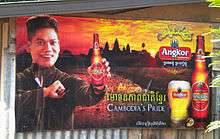
As a tropical sea-side resort, Sihanoukville’s night life is heavily influenced and characterized by the city's large number of beaches. All along the central tourist area between the Golden Lion Plaza and the Ochheuteal/Serendipity Beaches are international and Western styled night bars, live music venues and all-night beach discothèques.[118][119]
Most young Cambodians generally prefer to frequent classic style night-clubs with air-conditioning, lavish interiors and which are dedicated to more traditional ways of service procedures and cultural expression.
At Weather Station (Victory) Hill, bar operators tend to adopt certain traditional Asian and local elements of recreational services. Many Westerners consider these establishments as clearly part of the sex industry. With respect to the fact that prostitution is illegal, bar operators publicly avoid procedures that violate local ethic standards.[120]
Administration
Sihanoukville is the capital city of Sihanoukville province and is governed by its deputy governor. Sihanoukville occupies the greater part of four of the five communes or Sangkat(Sangkat Muoy Commune, Sangkat Pi Commune, Sangkat Bei Commune, Sangkat Buon Commune) of Sihanoukville provinces' Mittakpheap District. The port has its own autonomous administration.[121] The Sangkats are divided into 19 villages.
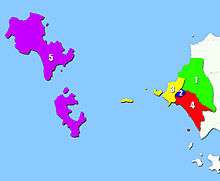
| The communes of Mittakpheap District[122] | |||||||||||||||||||||
|---|---|---|---|---|---|---|---|---|---|---|---|---|---|---|---|---|---|---|---|---|---|
| ISO Code | Commune | Romanization | Population | Sections | Urban | ||||||||||||||||
| 1801-1 | សង្កាត់ មួយ | Sangkat 1 | 37,440 | 3 | Yes | ||||||||||||||||
| 1801-2 | សង្កាត់ បីរ | Sangkat 2 | 25,142 | 3 | Yes | ||||||||||||||||
| 1801-3 | ស្ទឹងហាវ បី | Sangkat 3 | 13,108 | 3 | Majority | ||||||||||||||||
| 1801-4 | សង្កាត់ បយន | Sangkat 4 | 13,108 | 6 | Majority | ||||||||||||||||
| 1801-5 | សង្កាត់ កោះរ៉ុង | Sangkat Koh Rong | 1,108 | 4 | No | ||||||||||||||||
Autonomous Port
The Sihanoukville Autonomous Port lies within Sangkat 1 with an area of around 124.76 hectares (308.3 acres). The port is located 18 kilometres (11 mi) from the Kaong Kang Airport and 4 kilometres (2.5 miles) from Sihanoukville town centre. Ships' passengers are allowed to visit Sihanoukville town. The terminal itself offers apart from toilets, no further services, such as shopping centers, banking facilities or tourist offices, .[123]
Kampong Seila
Kampong Seila district, which belonged to Koh Kong Province has, per Royal decree, been transferred to Sihanoukville Province in January 2009: "The administrative boundaries of Preah Sihanouk municipality and Koh Kong province shall be adjusted by sub-dividing land from Kampong Seila district in whole and partial land of Sre Ambil district in Koh Kong province to Preah Sihanouk municipality." Officials were assigned to create a National Workshop - also in relation to other provinces - and process all necessary administrative tasks.[124] The National Institute of Statistics of Cambodia refers in its most recent and preliminary studies to a successful integration of the district, including maps,[125][126] although official statistics and numbers are expected to come with the next full report. Preah Sihanouk Province's new official domain has incorporated Kompong Seila district.[127]
Religion
Theravada Buddhism is state religion in Cambodia, with the pagoda as the traditional spiritual center of the community.[128] The most prominent pagodas in the city:
- Upper Pagoda, "Wat Chotynieng", or "Wat Leu"; located on a hill, overlooking Sihanoukville bay and dedicated to Samdech Preah Sangareach Chhoun Nath, a Cambodian Buddhist leader, who lived before the Khmer Rouge rule (1975).
- Lower Pagoda, "Wat Krom", located in Sihanoukville town. It is dedicated to Yeay Mao, a popular southern Cambodian ancestral spirit surrounded by an illustrious legend. Both - Wat Leu and Wat Krom - are named according to their local geographic location, on top of the hill and down at the bottom of the hill.
Sihanoukville city is also home to minor communities of other religions such as: Catholics, Muslims, Protestants and Taoists. Places of worship:
- St. Michael's Church: It is the center of the Catholic communities. The church was built in 1960 by sailors, it is located on the same hill as the Upper Pagoda, facing the sea.
- Iber Bikhalifah Mosque: It is the religious center of the local Muslim community. It is located in Sihanoukville town, just in the populous, central Psah Leu (upper market) area.
 A shrine for the ancestor's spirits.
A shrine for the ancestor's spirits.- Statue of Mary at Saint Francis de Sales Chapel
 Big Buddha statue on Victory Hill, October 2014
Big Buddha statue on Victory Hill, October 2014 a shrine to Yeay Mao at Independence Beach, October 2014
a shrine to Yeay Mao at Independence Beach, October 2014 St. Michael Catholic Church
St. Michael Catholic Church
Education
Public spending on education in Cambodia, totaled 2.60% (of GDP) as of 2010.[129]
Cambodian general education is based on the national school curriculum that consists of:
Basic education
The basic education curriculum is divided into three cycles of three years each. The first cycle (grade 1–3) consists of 27–30 lessons per week lasting 40 minutes which are allocated to five main subjects. The second cycle (grade 4-6) consists of the same number of lessons but is slightly different. The third cycle (grade 7-9) consists of 32-35 lessons which are allocated for 7 major subjects.[130]
Upper secondary education
The upper secondary education curriculum consists of two different phases. The curriculum for the first phase (grade 10) is identical to the third cycle of primary education. The second phase (grade 11-12) has two main components: Compulsory and electives.[130]
The total adult literacy rate of Sihanoukville is 95.37%.[131]
The city has experienced shortages of teachers[132] but the situation has improved during the last decade. The 2004 statistics show the following centers of education: 33 pre-schools with 1,670 children, 52 primary schools with 34,863 students, 5 colleges with 4,794 students; 2 high schools with 1,449 students; 10 vocational training with 961 students and 13,728 students in private schools. (see also chart below)
Unicef reports: Increase in reach and sustainability of children learning in relevant, inclusive and quality early childhood and basic education through increased institutional capacities.[133]
| Sihanoukville Educational Statistics 2004 | |||||||||||||||||||||||||||||||||||||||||||||||||||||||||||||||||||||||||||||||||||||||||||||||||||||||||||||||||||||||||||||||||||||||||||||||||||||||||||||||||||||||||||||||||||||||||||||||||||||||||||||||||||||||||||||||||||||||||||||||||||||||||||||||||||||
| Institution | Schools | Classes | Classrooms | Students | Teachers | ||||||||||||||||||||||||||||||||||||||||||||||||||||||||||||||||||||||||||||||||||||||||||||||||||||||||||||||||||||||||||||||||||||||||||||||||||||||||||||||||||||||||||||||||||||||||||||||||||||||||||||||||||||||||||||||||||||||||||||||||||||||||||||||||
|---|---|---|---|---|---|---|---|---|---|---|---|---|---|---|---|---|---|---|---|---|---|---|---|---|---|---|---|---|---|---|---|---|---|---|---|---|---|---|---|---|---|---|---|---|---|---|---|---|---|---|---|---|---|---|---|---|---|---|---|---|---|---|---|---|---|---|---|---|---|---|---|---|---|---|---|---|---|---|---|---|---|---|---|---|---|---|---|---|---|---|---|---|---|---|---|---|---|---|---|---|---|---|---|---|---|---|---|---|---|---|---|---|---|---|---|---|---|---|---|---|---|---|---|---|---|---|---|---|---|---|---|---|---|---|---|---|---|---|---|---|---|---|---|---|---|---|---|---|---|---|---|---|---|---|---|---|---|---|---|---|---|---|---|---|---|---|---|---|---|---|---|---|---|---|---|---|---|---|---|---|---|---|---|---|---|---|---|---|---|---|---|---|---|---|---|---|---|---|---|---|---|---|---|---|---|---|---|---|---|---|---|---|---|---|---|---|---|---|---|---|---|---|---|---|---|---|---|---|---|---|---|---|---|---|---|---|---|---|---|---|---|---|---|---|---|---|---|---|---|---|---|---|---|---|---|---|---|---|---|---|---|
| Preschool | 33 | 1670 | |||||||||||||||||||||||||||||||||||||||||||||||||||||||||||||||||||||||||||||||||||||||||||||||||||||||||||||||||||||||||||||||||||||||||||||||||||||||||||||||||||||||||||||||||||||||||||||||||||||||||||||||||||||||||||||||||||||||||||||||||||||||||||||||||||
| Primary school | 52 | 34863 | |||||||||||||||||||||||||||||||||||||||||||||||||||||||||||||||||||||||||||||||||||||||||||||||||||||||||||||||||||||||||||||||||||||||||||||||||||||||||||||||||||||||||||||||||||||||||||||||||||||||||||||||||||||||||||||||||||||||||||||||||||||||||||||||||||
| College | 5 | 4794 | |||||||||||||||||||||||||||||||||||||||||||||||||||||||||||||||||||||||||||||||||||||||||||||||||||||||||||||||||||||||||||||||||||||||||||||||||||||||||||||||||||||||||||||||||||||||||||||||||||||||||||||||||||||||||||||||||||||||||||||||||||||||||||||||||||
| Lycee | 2 | 1449 | |||||||||||||||||||||||||||||||||||||||||||||||||||||||||||||||||||||||||||||||||||||||||||||||||||||||||||||||||||||||||||||||||||||||||||||||||||||||||||||||||||||||||||||||||||||||||||||||||||||||||||||||||||||||||||||||||||||||||||||||||||||||||||||||||||
| Vocational training | 10 | 961 | |||||||||||||||||||||||||||||||||||||||||||||||||||||||||||||||||||||||||||||||||||||||||||||||||||||||||||||||||||||||||||||||||||||||||||||||||||||||||||||||||||||||||||||||||||||||||||||||||||||||||||||||||||||||||||||||||||||||||||||||||||||||||||||||||||
| Private schools | 27 | 13,728 | |||||||||||||||||||||||||||||||||||||||||||||||||||||||||||||||||||||||||||||||||||||||||||||||||||||||||||||||||||||||||||||||||||||||||||||||||||||||||||||||||||||||||||||||||||||||||||||||||||||||||||||||||||||||||||||||||||||||||||||||||||||||||||||||||||
| Sihanoukville Educational Statistics 2014[134] | |||||||||||||||||||||||||||||||||||||||||||||||||||||||||||||||||||||||||||||||||||||||||||||||||||||||||||||||||||||||||||||||||||||||||||||||||||||||||||||||||||||||||||||||||||||||||||||||||||||||||||||||||||||||||||||||||||||||||||||||||||||||||||||||||||||
| Institution | Schools | Classes | Classrooms | Students | Teachers | ||||||||||||||||||||||||||||||||||||||||||||||||||||||||||||||||||||||||||||||||||||||||||||||||||||||||||||||||||||||||||||||||||||||||||||||||||||||||||||||||||||||||||||||||||||||||||||||||||||||||||||||||||||||||||||||||||||||||||||||||||||||||||||||||
|---|---|---|---|---|---|---|---|---|---|---|---|---|---|---|---|---|---|---|---|---|---|---|---|---|---|---|---|---|---|---|---|---|---|---|---|---|---|---|---|---|---|---|---|---|---|---|---|---|---|---|---|---|---|---|---|---|---|---|---|---|---|---|---|---|---|---|---|---|---|---|---|---|---|---|---|---|---|---|---|---|---|---|---|---|---|---|---|---|---|---|---|---|---|---|---|---|---|---|---|---|---|---|---|---|---|---|---|---|---|---|---|---|---|---|---|---|---|---|---|---|---|---|---|---|---|---|---|---|---|---|---|---|---|---|---|---|---|---|---|---|---|---|---|---|---|---|---|---|---|---|---|---|---|---|---|---|---|---|---|---|---|---|---|---|---|---|---|---|---|---|---|---|---|---|---|---|---|---|---|---|---|---|---|---|---|---|---|---|---|---|---|---|---|---|---|---|---|---|---|---|---|---|---|---|---|---|---|---|---|---|---|---|---|---|---|---|---|---|---|---|---|---|---|---|---|---|---|---|---|---|---|---|---|---|---|---|---|---|---|---|---|---|---|---|---|---|---|---|---|---|---|---|---|---|---|---|---|---|---|---|---|
| Preschool | 44 | 64 | 60 | 1715 | 72 | ||||||||||||||||||||||||||||||||||||||||||||||||||||||||||||||||||||||||||||||||||||||||||||||||||||||||||||||||||||||||||||||||||||||||||||||||||||||||||||||||||||||||||||||||||||||||||||||||||||||||||||||||||||||||||||||||||||||||||||||||||||||||||||||||
| Primary school | 73 | 800 | 532 | 26212 | 778 | ||||||||||||||||||||||||||||||||||||||||||||||||||||||||||||||||||||||||||||||||||||||||||||||||||||||||||||||||||||||||||||||||||||||||||||||||||||||||||||||||||||||||||||||||||||||||||||||||||||||||||||||||||||||||||||||||||||||||||||||||||||||||||||||||
| Secondary school | 27 | 260 | 269 | 11889 | 725 | ||||||||||||||||||||||||||||||||||||||||||||||||||||||||||||||||||||||||||||||||||||||||||||||||||||||||||||||||||||||||||||||||||||||||||||||||||||||||||||||||||||||||||||||||||||||||||||||||||||||||||||||||||||||||||||||||||||||||||||||||||||||||||||||||
| College | 20 | 114 | 107 | 4577 | 318 | ||||||||||||||||||||||||||||||||||||||||||||||||||||||||||||||||||||||||||||||||||||||||||||||||||||||||||||||||||||||||||||||||||||||||||||||||||||||||||||||||||||||||||||||||||||||||||||||||||||||||||||||||||||||||||||||||||||||||||||||||||||||||||||||||
| Lycee | 7 | 155 | 153 | 7312 | 407 | ||||||||||||||||||||||||||||||||||||||||||||||||||||||||||||||||||||||||||||||||||||||||||||||||||||||||||||||||||||||||||||||||||||||||||||||||||||||||||||||||||||||||||||||||||||||||||||||||||||||||||||||||||||||||||||||||||||||||||||||||||||||||||||||||
| Lycees with grade 10–12 only | 1 | 31 | 31 | 1366 | 87 | ||||||||||||||||||||||||||||||||||||||||||||||||||||||||||||||||||||||||||||||||||||||||||||||||||||||||||||||||||||||||||||||||||||||||||||||||||||||||||||||||||||||||||||||||||||||||||||||||||||||||||||||||||||||||||||||||||||||||||||||||||||||||||||||||
Private educational institutes in Sihanoukville
- Life University
- University of Management and Economics
- Built Bright University
- Khmer Technology and Management Center
- Don Bosco Technical School
- Don Bosco Hotel School.
 Ribbon cutting ceremony of the Engineer Civic Action Project
Ribbon cutting ceremony of the Engineer Civic Action Project- Cambodians doing an exam in order to apply for the Don Bosco Technical School of Sihanoukville in 2008.
 His Majesty Norodom Sihamoni officially opened the Don Bosco Hotel School.
His Majesty Norodom Sihamoni officially opened the Don Bosco Hotel School. Sovannaphumi Primary school in central Sihanoukville, October 2014
Sovannaphumi Primary school in central Sihanoukville, October 2014 Antaraktvib multi-grade school and kindergarten in central Sihanoukville, October 2014
Antaraktvib multi-grade school and kindergarten in central Sihanoukville, October 2014
International relations
Twin towns — Sister cities
Sihanoukville is twinned with:
See also
- Sihanoukville Autonomous Port
- Sihanoukville International Airport
- Ream National Park
- Koh Rong
- Koh Rong Sanloem
- Sihanoukville province
- Special Economic Zones of Cambodia
Bibliography
- Vann, hokchrea (2003). Modern Khmer Cities. Cambodia: Reyum Press. ISBN 9789995055349.
- Chandler, David (1993). A History of Cambodia. Cambodia: Allen & Unwin. ISBN 9781863734653.
- Cœdès, George (1966). The making of South East Asia. University of California Press. ISBN 0-520-05061-4.
- Kitagawa, T. 2005, "'Kampot' of the belle époque: from the outlet of Cambodia to a colonial rule", in Southeast Asian Studies = Tonan Ajia kenkyu, vol. 42, no. 4,
- Kampot of the Belle Epoque: From the Outlet of Cambodia to a Colonial Resort
- Henri Mouhot: Travels in Siam, Cambodia, Laos, and Annam, White Lotus Co, Ltd., ISBN 974-8434-03-6
- Cœdès, George (1968). The Indianized States of Southeast Asia. University of Hawaii Press. ISBN 978-0824803681.
- Philpotts, Robert (2006). A Port for Independence. England: Blackwater Books. ISBN 2-9513524-0-9.
References
- ↑ "Administrative Areas in Sihanoukville Municipality by District and Commune" (PDF). Statistics Japan. Retrieved April 18, 2015.
- ↑ "General Population Census of Cambodia 2008" (PDF). National Institute of Statistics. Retrieved April 18, 2015.
- ↑ Philpotts, Robert (March 2006). A Port for Independence. England: Blackwater Books. p. 18.
- ↑ "Economic Corridors and Industrial Estates, Ports and Alternative Roads in Cambodia" (PDF). IDE-JETRO. Retrieved April 18, 2015.
- ↑ "Cambodia Re-emerges". The New York Times. October 19, 2003. Retrieved May 19, 2016.
- ↑ "Kompong Som". Sandbox Networks, Inc. Retrieved June 6, 2016.
- ↑ "The rise of Sihanoukville". The Phnom Penh Post. March 21, 2013. Retrieved April 18, 2015.
- ↑ "Sar Kheng Orders End to Illegal Fishing Off Coast". templenews org. September 8, 2015. Retrieved December 29, 2015.
- ↑ "East Asia Ports in their Urban Context" (PDF). Open Knowledge Repository. January 1, 2003. Retrieved April 18, 2015.
- ↑ "Officials Unable to Explain Mystery Ships". The Cambodia Daily. November 6, 2015. Retrieved November 6, 2015.
- ↑ "Sure, Sihanoukville would never win first prize in a pretty-town competition...". Lonely Planet. Retrieved June 25, 2016.
- ↑ "No Power Leads to No Water in Sihanoukville". The Cambodia Daily. April 2, 2013. Retrieved April 18, 2015.
- ↑ "Sihanoukville, Preah S". Cambodia Geographic Names Database. Retrieved May 12, 2015.
- ↑ Cat Barton (September 7, 2007). "Cambodia: King Father Sihanouk holds ECCC at bay". Asian Human Rights Commission. Retrieved February 5, 2008.
- ↑ Headly, Robert K.; Chhor, Kylin; Lim, Lam Kheng; Kheang, Lim Hak; Chun, Chen. 1977. Cambodian-English Dictionary. Bureau of Special Research in Modern Languages. The Catholic University of America Press. Washington, D.C. ISBN 0-8132-0509-3
- ↑ "View Dictionary". Sanskritdictionary.com. Retrieved 2014-03-07.
- ↑ "kampong - definition of kampong in English from the Oxford dictionary". Oxford Dictionaries. Retrieved May 12, 2015.
- ↑ A History of Cambodia. Google Books. Retrieved May 12, 2015.
- ↑ "The History of the Vinh Te Canal". UNREPRESENTED NATIONS AND PEOPLES ORGANIZATION. January 27, 2004. Retrieved April 18, 2015.
- ↑ http://21provinces.blogspot.com/2011/08/true-history-of-khmer-krom.html
- ↑ "PRE-ANGKORIAN SETTLEMENT TRENDS IN CAMBODIA'S MEKONG DELTA AND THE LOWER MEKONG" (PDF). University of Hawaii. Retrieved April 18, 2015.
- ↑ "Essay on Cambodian History from the middle of the 14th to the beginning of the 16th Centuries" (PDF). Sophia Angkor University. Retrieved April 18, 2015.
- ↑ "The History of Cambodia - Justin Corfield". Google Books. Retrieved June 7, 2015.
- ↑ Maritime China in Transition 1750-1850. Google Books. Retrieved April 18, 2015.
- ↑ "Kampot's Chinese heritage unearthed". Phnom Penh Post. January 31, 2013. Retrieved April 18, 2015.
- ↑ "Southeast Asia: A Historical Encyclopedia, from Angkor Wat to East... Volume 1". Google Books. Retrieved June 7, 2015.
- 1 2 "Kampot of the Belle Époque: From the Outlet of Cambodia to a Colonial Resort" (PDF). Center for Southeast Asian Studies, Kyoto. Retrieved April 18, 2015.
- ↑ "London Company's Envoys Plot Siam" (PDF). Siamese Heritage. Retrieved May 7, 2015.
- ↑ "THE MEKONG EXPLORATION COMMISSION,1866–68: ANGLO-FRENCH RIVALRY IN SOUTH EAST ASIA" (PDF). Wikispaces. Retrieved April 18, 2015.
- ↑ "Sihanouk Ville" (PDF). Phnom Penh tours. Retrieved May 7, 2015.
- ↑ "GOOD QUESTIONS WRONG ANSWERS - CIA's Estimates..." (PDF). The National Security Archive. Retrieved May 7, 2015.
- ↑ US Department of Defense document "History of the Pacific Air Forces 1 July 1974-31 Dec 1975". p 426. accessed 24 Nov 2013
- ↑ "Sihanoukville port sees 14 pct rise in cargo". the cambodia herald. June 13, 2013. Retrieved June 25, 2016.
- ↑ "POLICY OPTIONS FOR CAMBODIA'S REAM NATIONAL PARK" (PDF). International Development Research Centre. Retrieved May 7, 2015.
- ↑ "King Sihamoni signed a royal decree that would change the municipalities of Kep, Sihanoukville and Pailin into provinces". Newsgroups derkeiler. January 1, 2009. Retrieved May 7, 2015.
- ↑ "Snake Island plans back to the drawing board". Phnom Penh Post. November 20, 2013. Retrieved June 1, 2015.
- ↑ "Luxury resort looks for new lease of life with redesigned blueprint". Phnom Penh Post. April 10, 2014. Retrieved June 1, 2015.
- ↑ "Cambodia Joins World's Most Beautiful Bay Club; Sihanoukville to Host First Sea Festival". PEMSEA. July 1, 2011. Retrieved May 7, 2015.
- ↑ "CITIES AND CLIMATE CHANGE INITIATIVE SIHANOUKVILLE CAMBODIA" (PDF). Urban Gateway. Retrieved May 7, 2015.
- ↑ "The City He Built". The New York Times Company. May 15, 2005. Retrieved June 1, 2015.
- ↑ "Vann Molyvann: my legacy will disappear". Phnom Penh Post. January 25, 2013. Retrieved June 1, 2015.
- ↑ "Sihanoukville Runs Dry During Water Crisis". The Cambodia Daily. April 1, 2013. Retrieved May 7, 2015.
- ↑ "Layout Of Sihanoukville". Bayon Pearnik. Retrieved June 1, 2015.
- ↑ "Sihanoukville". Footprint Travel Guides 2015. Retrieved June 1, 2015.
- ↑ "Hotels Warned Over Pumping Sewage Into Sea". The Cambodia Daily. May 9, 2015. Retrieved June 11, 2015.
- ↑ "Ochheuteal Beach - Sihanouk ville". Tourism of Cambodia. Retrieved June 1, 2015.
- 1 2 "Sihanoukville Beaches". Cambodia islands – Island Species Cambodia. Retrieved May 7, 2015.
- ↑ "Ochheuteal Beach - What to See". Tourism Cambodia. Retrieved May 7, 2015.
- ↑ http://www.sokhahotels.com/sihanoukville/
- ↑ "THE NEW BANANA PANCAKE TRAIL: 2014'S TOP SOUTHEAST ASIA BACKPACKER SPOTS". Travel And Escape. Retrieved May 7, 2015.
- ↑ "Cambodia in Focus : Developing Tourist Resorts Islands". Embassyofcambodia.org.nz. Retrieved 2014-03-07.
- ↑ "Sihanoukville weather in January". CambodiaWeather net com. Retrieved May 27, 2015.
- ↑ "Climatological Information for Sihanoukville, Cambodia", Hong Kong Observatory, 2003. Web: KOS-Airport.
- ↑ "$70 million earmarked for Sihanoukville terminals". The Phnom Penh Post. January 28, 2009. Retrieved May 7, 2015.
- ↑ "Investment Climate Survey in Cambodia" (PDF). ERIA for ASEAN. Retrieved May 7, 2015.
- ↑ "Cambodia Trade Corridor Performance Assessment - 4.1 Phnom Penh – Sihanoukville Corridor" (PDF). Worldbank. Retrieved October 12, 2016.
- ↑ "Homage to the new Cambodia". Telegraph Media Group. March 6, 2012. Retrieved October 12, 2016.
- ↑ "Preah Sihanouk Province". Council for the Development of Cambodia(CDC). Retrieved May 7, 2015.
- ↑ "Investment Advantage". Cambodia Sihanoukville Special Economic Zone. Retrieved May 7, 2015.
- ↑ "Sihanoukville Special Economic Zone". Cambodia Sihanoukville Special Economic Zone. Retrieved May 7, 2015.
- ↑ "Cambodian, Chinese companies lay foundation of special economic zone in Sihanoukville". CAAI News Media. February 24, 2008. Retrieved June 25, 2016.
- 1 2 3 "Preah Sihanouk Province". Council for the Development of Cambodia(CDC), Cambodian Investment Board(CIB), Cambodian Special Economic Zone Board(CSEZB). Retrieved May 12, 2015.
- ↑ "Cambodia Trade". Encyclopædia Britannica. Retrieved May 7, 2015.
- ↑ "Industrial Agglomeration, Production Networks and Foreign Direct Investment Promotion: Cambodia's Experience" (PDF). ERIA: Economic Research Institute for ASEAN and East Asia. March 1, 2008. Retrieved May 7, 2015.
- 1 2 "ECONOMIC AFFAIRS OFFICE - Doing Business in Cambodia". U.S. Department of State. Retrieved May 27, 2015.
- ↑ "Trade Information, Ministry of Commerce, Cambodia". Ministry of Commerce. Retrieved May 27, 2015.
- ↑ "modernisation of Cambodia's main port of Sihanoukville continues amidst worldwide slowdown of traffic in bigger ports such as Los Angeles and Long Beach". derkeiler com. January 22, 2009. Retrieved May 27, 2015.
- ↑ "Sihanoukville Autonomous Port(PAS) - Sihanoukville, Cambodia". SihanoukVille Web. Retrieved May 27, 2015.
- ↑ http://pas.gov.kh/traffic-handling.html
- ↑ "SOUTH CHINA SEA AND THE GULF OF THAILAND - SAILING DIRECTIONS p.182" (PDF). NATIONAL GEOSPATIAL-INTELLIGENCE AGENCY. May 1, 2014. Retrieved June 7, 2016.
- ↑ "Cargo giants call on Sihanoukville port". Phnom Penh Post. March 17, 2016. Retrieved June 25, 2016.
- ↑ "Travel Guide for Sihanoukville". realtravel.com. Retrieved February 5, 2009.
- ↑ In isolated hills of Asia, new roads to speed trade., Thomas Fuller, New York Times, 31-03-2008.
- ↑ "Roads". Council of the Development of Cambodia. Retrieved June 1, 2015.
- ↑ "Transport in Cambodia". The World Bank. Retrieved May 7, 2015.
- 1 2 "Cambodia Traffic Law". SCO Cambodia. Retrieved May 12, 2015.
- ↑ "1985 Agreement on the Recognition of Domestic Driving Licenses Issued by ASEAN Countries". Centre for International Law. July 9, 1985. Retrieved May 7, 2015.
- ↑ "There are road rules - but who cares!". Phnom Penh Post. August 29, 2003. Retrieved June 1, 2015.
- ↑ "CAMBODIA Traffic deaths soar on rapid urbanisation". khmerisation. September 8, 2008. Retrieved May 7, 2015.
- ↑ "Foreign travel advice Cambodia". Gov.UK. Retrieved May 7, 2015.
- ↑ "Cambodia: more deaths on the roads than in minefields". International Federation of Red Cross and Red Crescents. September 20, 2007. Retrieved February 5, 2009.
- ↑ "'Express service' skirts new driving license law". Phnom Penh Post. November 1, 2007. Retrieved June 1, 2015.
- ↑ Sok Khemara, Voa Khmer (January 3, 2009). "Police begin enforcement". Retrieved February 5, 2009.
- ↑ "Training Course on Risk Factors Capacity Building of Helmet and Seat Belt Wearing and Drink-Driving". AKP. August 29, 2014. Retrieved May 12, 2015.
- ↑ "Road safety in Cambodia". WHO Cambodia. Retrieved May 12, 2015.
- ↑ "Getting Around Sihanoukville". sihanoukvillebackpacker.com. Retrieved February 5, 2009.
- ↑ "Airline Companies in Cambodia - Transportation in Cambodia". Ministry of Tourism Cambodia (MOT). Retrieved May 12, 2015.
- ↑ "Bus Company in Cambodia - Transportation in Cambodia". Ministry of Tourism Cambodia (MOT). Retrieved May 12, 2015.
- ↑ "Cambodia - Bus Schedules and Companies". Canby Publications. Retrieved May 12, 2015.
- ↑ "Domestic Bus Schedules". i-Tourist Information. Retrieved May 12, 2015.
- ↑ "Sihanoukville to Koh Rong – Speed Ferry Cambodia". Speed Ferry Cambodia. Retrieved 6 May 2016.
- ↑ "MARINA OCEANIA SIHANOUKVILLE CAMBODIA". MARINA OCEANIA. Retrieved May 12, 2015.
- ↑ "Cruise Ship Docks at Preah Sihanoukville International Seaport". Cambodia Grand Tour. February 9, 2013. Retrieved May 12, 2015.
- ↑ "News Update". Toll Royal Railways (Cambodia). February 16, 2015. Retrieved May 12, 2015.
- ↑ "General Population Census of Cambodia 2008 - Provisional population totals" (PDF). National Institute of Statistics, Ministry of Planning. September 3, 2008.
- ↑ "POPULATION PROJECTIONS FOR CAMBODIA, 2008-2030" (PDF). The Statistics Bureau and the Director-General for Policy Planning of Japan. Retrieved May 12, 2015.
- ↑ Normal Template, . Retrieved 2012.
- ↑ "AN INVESTMENT GUIDE TO CAMBODIA - Water, sewerage and health services" (PDF). UNCTAD. Retrieved May 12, 2015.
- ↑ "Cambodia Public Health". PHOTIUS. Retrieved May 12, 2015.
- ↑ "Cambodia - Health". U.S. Department of State. October 21, 2014. Retrieved May 27, 2015.
- ↑ "Cambodia: Angkor Wat - HEALTH ISSUES". Centers for Disease Control and Prevention. Retrieved June 18, 2015.
- ↑ "Sihanoukville: Emergency Services". Canby Publications. Retrieved May 12, 2015.
- ↑ "Sihanoukville General Hospital". The SihanoukVille Hospital Sihanouk Ville, Cambodia. Retrieved May 12, 2015.
- ↑ "Cambodia Chinese Religion". Photius. Retrieved May 12, 2015.
- ↑ "Task Force Meeting 7th: Reporting Through Smartphone". Urban Voice Cambodia. October 23, 2014. Retrieved May 12, 2015.
- ↑ "A history of the Chinese in Cambodia by Jean-Michel Filippi". Phnom Penh Post. February 8, 2013. Retrieved June 20, 2015.
- ↑ The Chinese in Cambodia. Google Books. Retrieved May 12, 2015.
- ↑ "Cambodia Today - The Life of The Khmers Today". Holiday In Angkor Wat. Retrieved May 12, 2015.
- ↑ "Corruption hits urban families hardest, study shows". Phnom Penh Post. March 11, 2005. Retrieved May 12, 2015.
- ↑ "Sihanoukville Hotels & Guesthouses". Canby Publications. Retrieved May 12, 2015.
- ↑ "Song Saa Private Island: Stunning Barefoot Luxury In Cambodia". Forbes. January 4, 2014. Retrieved May 12, 2015.
- ↑ "Cambodia Tourist Statistic 2013". Cambodia Tourism. Retrieved May 12, 2015.
- ↑ "Cambodia Tourist Statistic 2014". Cambodia Tourism. May 17, 2014. Retrieved May 12, 2015.
- ↑ "Cambodia Tourist Statistic 2014". Cambodia Tourism. May 17, 2014. Retrieved May 12, 2015.
- ↑ "Sihanoukville - Beach Resort - What to See in Cambodia - Cambodia Major Attractions". Tourism Cambodia. Retrieved May 14, 2015.
- ↑ http://www.cambodiainvestment.gov.kh/preah-sihanouk-province.html
- ↑ http://www.cambodiainvestment.gov.kh/#fragment-4-tab
- ↑ "Sihanoukville - Beach Resort". Tourism Cambodia. May 17, 2014. Retrieved May 12, 2015.
- ↑ "Sihanoukville Bars & Nightlife". Canby Publications. May 17, 2014. Retrieved May 12, 2015.
- ↑ "Night-Life". Cambodia islands – Island Species Cambodia. Retrieved May 7, 2015.
- ↑ "The Sihanoukville Autonomous Port (PAS)". pas.gov.kh. Retrieved February 5, 2009.
- ↑ "Map 18. Administrative Areas in Preah Sihanouk Province by District and Commune" (PDF). Statistics Japan. Retrieved May 14, 2015.
- ↑ "Port Autonome De Sihanoukville". Port Autonome De SihanoukVille. Retrieved June 1, 2015.
- ↑ "Closing Speech by HE Sar Kheng at National Workshop on the Formulation of the 2013 NCDD Annual Work Plan and Budget on 11-12 December 2012, Phnom Penh" (PDF). NCDD. Retrieved May 12, 2015.
- ↑ "Preliminary Results of Cambodia Inter-censal Economic Survey 2014" (PDF). National Institute of Statistics. Retrieved May 12, 2015.
- ↑ "Census of Agriculture in Cambodia 2013 Preliminary Report" (PDF). National Institute of Statistics. Retrieved May 12, 2015.
- ↑ "ដ្ឋបាលខេត្តព្រះសីហនុ - Home". Sihanoukville Gov. Retrieved May 12, 2015.
- ↑ "ដCambodia Role of Buddhism in Cambodian Life". Photius. Retrieved May 12, 2015.
- ↑ "Cambodia - Public spending on education". Indexmundi. Retrieved May 12, 2015.
- 1 2 "The Education System in Cambodia". Bookbridge. March 19, 2012. Retrieved May 12, 2015.
- ↑ "GENDER EQUALITY AND WOMEN'S EMPOWERMENT IN PUBLIC ADMINISTRATION" (PDF). United Nations Development Programme. Retrieved May 12, 2015.
- ↑ "Sihanoukville Faces Severe Teacher Shortage". The Cambodia Daily. October 18, 2004. Retrieved May 12, 2015.
- ↑ "UNICEF Annual Report 2012 for Cambodia, EAPRO" (PDF). UNICEF. Retrieved May 12, 2015.
- ↑ "Education Statistics 2013-2014". Ministry of Education, Youth and Sport. Retrieved May 14, 2015.
External links
Government
- Preah Sihanouk Province official homepage
- Ministry of Tourism
- National Institute of Statistics of Cambodia
- Royal Government of Cambodia (English Version)
- Sihanoukville Autonomous Port
- Agence Kampuchea Presse
- Ministry of Public Works and Transport
- Council of the Development of Cambodia
- Sihanoukville Wastewater Treatment facility
Industry
- Sihanoukville Special Economic Zone(SSEZ)
- Toll Royal Railways - Cambodian rail operator
- Chemical Waste Dumped near Sihanoukville
- Cambodia Airports
Info, history and geography
- Kampotmuseum
- Cambodian Research Centre for Development (CRCD)
- Cambodia’s islands - Island Species Cambodia
- Canbypublications
